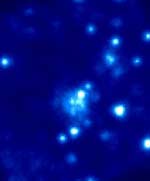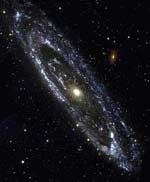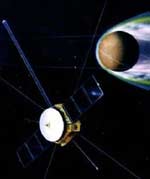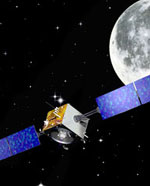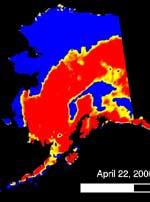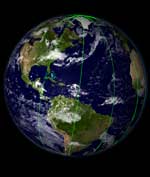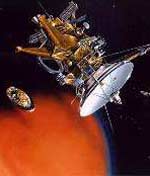
Image credit: NASA/JPL
NASA’s Saturn-bound spacecraft, Cassini, has made the first observation of interstellar pickup ions beyond the orbit of Jupiter. These are neutral particles in the solar system that get ionized when they get too close to the Sun, and then travel outwards with the solar wind. These ions have been seen near the Earth, but never out past the orbit of Jupiter. By measuring these particles, astronomers will have a better understanding of the low-density gas and dust that exists between the stars.
More than a year before the Cassini spacecraft arrives at Saturn, the Cassini Plasma Spectrometer (CAPS) has made the first in situ observations of interstellar pickup ions beyond the orbit of Jupiter. This is the first major discovery using data gathered by CAPS, destined to reach Saturn in July 2004.
Pickup ions are neutral particles in the solar system that become ionized near the Sun and join the solar wind, the supersonic stream of charged particles flowing out from the Sun. By observing these pickup ions, researchers can better understand the interstellar medium, the low-density gas and dust that fill the space between stars.
Astronomers have observed interstellar pickup ions as early as 1985 from a distance of 1 astronomical unit (AU, the distance from the Earth to the Sun), but never before have they seen pickup ions beyond 5 AU — Jupiter’s orbit. The CAPS team uploaded software that allowed the instrument to collect and transmit detections of the relatively rare pickup ions it encounters on its journey to Saturn.
During the observation period of October 2001 to February 2003 at distances of 6.4 to 8.2 AU, the instrument collected 2,627 samples. Analyses revealed that there is a strong depletion of hydrogen pickup ions compared to helium pickup ions in the region behind the Sun. The team determined that this newly observed depletion, or “interstellar hydrogen shadow,” is produced by radiation pressure and ionization of the neutrals. Most hydrogen atoms cannot penetrate into the downstream shadow region because they must pass near the Sun where they have a high probability of being ionized and swept out with the solar wind.
“These are very hard particles to measure because there are so few of them,” says Dr. David J. McComas, senior executive director of the SwRI Space Science and Engineering Division. “Previous models have included something like this interstellar hydrogen shadow, but these are the first direct measurements of it.”
Institute Scientist Dr. David T. Young is principal investigator of the CAPS instrument, the largest, most complex space plasma instrument flown to date, which will detect and analyze plasma (electrons and ions) found throughout the solar system. The overall mission of the Cassini spacecraft is to image the Saturn system at infrared, ultraviolet and visible wavelengths and to directly sample the dust, neutral and charged particle environment. Cassini also carries the Huygens probe, built by the European Space Agency, to study Saturn’s moon, Titan.
“This is certainly the first of many new discoveries to come by the Cassini spacecraft, and the Cassini Plasma Spectrometer in particular,” says McComas. “To have been able to make such an important contribution to heliospheric phenomenon on the way out to Saturn has been a great treat.”
SwRI also leads a feasibility study for the proposed Interstellar Boundary Explorer (IBEX) program, one of five candidates vying to fill two NASA mission slots. If selected, the program would launch a pair of energetic neutral atom cameras to directly image the interaction between the solar system and the interstellar medium – the region that the interstellar neutrals must flow through to enter the heliosphere.
The paper “The Interstellar Hydrogen Shadow: Observations of Interstellar Pickup Ions Beyond Jupiter,” is being presented December 9 at the American Geophysical Union (AGU) meeting in San Francisco and is in press in the Journal of Geophysical Research.
Original Source: SWRI News Release

